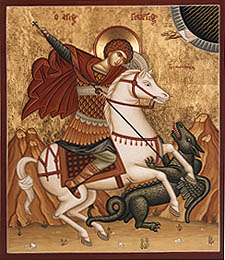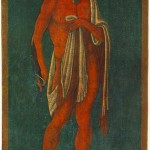Here at Geek Goes Rogue, we love the Saints. These folks are like real, live comic book characters come to life. So, every week, we are going to feature these awesome, wacky, beautiful and faithful people of God.
Today’s saint?
St. George
From the Catholic Encyclopedia:
The best known form of the legend of St. George and the Dragon is that made popular by the “Legenda Aurea”, and translated into English by Caxton. According to this, a terrible dragon had ravaged all the country round a city of Libya, called Selena, making its lair in a marshy swamp. Its breath caused pestilence whenever it approached the town, so the people gave the monster two sheep every day to satisfy its hunger, but, when the sheep failed, a human victim was necessary and lots were drawn to determine the victim. On one occasion the lot fell to the king’s little daughter. The king offered all his wealth to purchase a substitute, but the people had pledged themselves that no substitutes should be allowed, and so the maiden, dressed as a bride, was led to the marsh. There St. George chanced to ride by, and asked the maiden what she did, but she bade him leave her lest he also might perish. The good knight stayed, however, and, when the dragon appeared, St. George, making the sign of the cross, bravely attacked it and transfixed it with his lance. Then asking the maidenfor her girdle (an incident in the story which may possibly have something to do with St. George’s selection as patron of the Order of the Garter), he bound it round the neck of the monster, and thereupon the princess was able to lead it like a lamb. They then returned to the city, where St. George bade the people have no fear but only be baptized, after which he cut off the dragon’s head and the townsfolk were all converted. The king would have given George half his kingdom, but the saint replied that he must ride on, bidding the king meanwhile take good care of God’s churches, honour the clergy, and have pity on the poor. The earliest reference to any such episode in art is probably to be found in an old Roman tombstone at Conisborough in Yorkshire, considered to belong to the first half of the twelfth century. Here the princess is depicted as already in the dragon’s clutches, while an abbot stands by and blesses the rescuer.
Okay, so none of this legend is true, and the real story of St. George tearing down an edict of Diocletian is still pretty bad ass.
St. George, pray for us as we struggle with evil in our own hearts and in the heart of the world.












